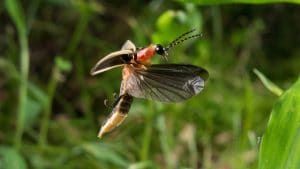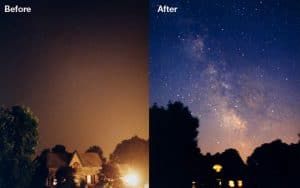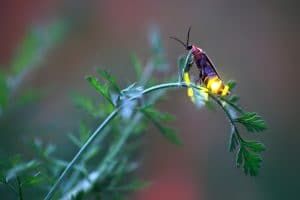“Like a tiny galaxy descended into the forest”—new species of firefly found
By Joanna Thompson | April 30, 2021
 Image courtesy Radim Schreiber/ fireflyexperience.org and National Park Service
Image courtesy Radim Schreiber/ fireflyexperience.org and National Park Service
Editor’s note: This story was originally published by Atlas Obscura. It appears here as part of the Climate Desk collaboration.
Clyde Sorenson had a hunch.
Archival data from the North Carolina Entomological Museum’s collection had led him to suspect that some of the fireflies atop Grandfather Mountain in western North Carolina might be more than the average lightning bug. An entomologist at North Carolina State University, Sorenson is the sort of college professor who challenges his students to write a Shakespearean sonnet praising their favorite insect. He headed up to the mountains in the summer of 2019, and while staying in one of Grandfather’s cabins, he decided to do a little investigating.
“I got finished dinner, and I started poking around, turning on the porch light,” he says. “When it got good and dark, the synchronous fireflies started to show up. I was tickled on two scores: one, it’s really cool to see them. And two, I was right.”
Sorenson had uncovered a population of synchronous fireflies pulsing in the heart of North Carolina’s Blue Ridge mountain range. Firefly displays vary wildly, depending on the species. Some, like the common Big Dipper firefly, flash in low, long swoops. Others hover close to the ground, glowing faintly and steadily, like the eerie Blue Ghost. But most displays are asynchronous—each bug creates its own beat.
Photinus carolinus, the species that Sorenson found, is one of a small handful of synchronous firefly species in the world. These insects flash together in six-to-eight quick bursts, then go dark for eight seconds. Biologists suspect that the pause evolved to confuse predators, allowing the fireflies to find a mate under brief cover of darkness.
Unlike most beetles—and yes, they are beetles—fireflies are soft-bodied. That means that they have very specific humidity and moisture needs. Southern Appalachia’s temperate rainforests—and yes, they are rainforests—provide the perfect habitat.

P. carolinus was once thought mostly to be confined to the Great Smoky Mountains, a subrange of the Appalachians running along the Tennessee/North Carolina border. But in the last two years, populations have turned up in Grandfather Mountain State Park in North Carolina and Watoga State Park in West Virginia, where retired park ranger Ken Springer encountered them by following some GPS coordinates he received in an email from a biologist.
Springer knows Watoga State Park’s woods like the tops of his battered running shoes. On a warm night in June 2020, he hiked out with a small team of park rangers, scientists, and natural resource managers to the headwaters of a little creek and waited until nightfall. “There were the normal fireflies that we saw at first,” recalls Springer. Then, all of a sudden, something else: “Beautiful flashes, simultaneous flashes, all these insects at one time. And then they stop. And we start counting.”
Now that word has gotten out, local landowners and park managers are seeking the best way to manage their newly found ecological treasure. And that means grappling with tough decisions about the tourists they attract. Natural wonders draw visitors in, but those same guests could unintentionally put fragile species at risk.
Every June, thousands of tourists swarm Tennessee’s Great Smoky Mountains National Park for a glimpse of its famous synched fireflies, which light up the forest like a coordinated Christmas display. The National Park Service hosts an annual “firefly lottery,” where entrants vie for a chance at a nighttime picnic surrounded by tiny, twinkling bugs.
But this type of ecotourism is not without controversy. On one hand, it’s great for inspiring budding naturalists and supporting the park. On the other, some ecologists worry that the influx of humans could upset the delicate ecosystem.
Candace Fallon, a senior endangered species conservation biologist with the Xerces Society for Invertebrate Conservation, works on developing sustainable practices for viewing charismatic insects like fireflies. Tourism is an important part of conservation, she says, but it can be a double-edged sword. With their small size and fragile wings, many insects are easily harmed by a swatting hand or stamping human foot. And fireflies are even more delicate than most winged insects.
“There are a lot of species that have flightless females,” says Fallon. Those earthbound females, along with their larvae, are in danger of being trampled to death by hapless tourists. Nocturnal courtship, Fallon adds, “definitely makes them more vulnerable to things like light pollution.” Camera flashes, illuminated pathways, even car headlights can disrupt fireflies’ mating rituals.
This is the kind of dilemma that keeps Lynn Faust up at night. Faust, author of Fireflies, Glow-worms, and Lightning Bugs, grew up in the synchronous firefly Mecca of Elkmont, Tennessee, which is now part of Great Smoky Mountains National Park. She remembers watching fireflies’ light show as a young girl, but it wasn’t until later that their significance became apparent to her. “I had realized by 1990 that what we were enjoying each June in Elkmont was simply not like what I had seen everywhere else,” Faust recalls.

In 1992, insect experts confirmed that Elkmont’s fireflies were indeed synchronous. After the announcement, tourists started trickling in each summer to see the bugs. And they kept coming.
“By about the year 2000, crowds were beginning to be a problem,” says Faust. “A few people don’t hurt much, but when you get thousands every night with no management it gets out of hand quickly.” Elkmont transformed into one long traffic jam, flooding the woods with disruptive headlights. Soon, it was difficult for the Park’s researchers to even find an undisturbed firefly display.
Faust joined forces with folks like Becky Nichols, an entomologist from the National Park Service, to institute the lottery system as a way to manage crowds. “You don’t want to keep it secret,” Nichols says, “But you have to draw the line and limit it somehow.” Today, guests purchase nearly 30,000 of the $1 lottery tickets per year, and 1,800 lucky entrants are selected for viewing over the span of eight nights.
Writing in the journal Conservation Science and Practice, an international team of researchers led by Tufts University biologist Sara Lewis recently estimated that more than a million people each year travel to watch fireflies work their magic. And, of course, different sites handle their firefly populations—and their human visitors—differently. “The National Park Service and the Smokies have done a reasonably good job,” says Lewis, who is also co-chair of the firefly specialist group for the International Union for the Conservation of Nature. However, she says, measures like guardrails or viewing platforms, which are employed by some international firefly tourist sites, might go even further to protect juveniles hiding in the leaf litter.
For its part, Watoga State Park is applying for an International Dark Sky designation, among the first issued in the Southeast. This could safeguard the park’s insects from light pollution by banning fluorescent bulbs in and around the park.

Mack Frantz, a zoologist for West Virginia’s species diversity program, thinks that offering guided firefly tours could help conservation as well. “Once the cat’s out of the bag, people are going to want to see these things,” he says. If guides are available to keep people out of the leaf litter and provide cellophane filters for cell phone light, “we’re hoping we can protect them right.”
Grandfather Mountain is also considering applying for Dark Skies status, but unlike the populations in Tennessee and West Virginia, Grandfather’s fireflies are squatting on private property. This presents a unique challenge compared with government-maintained sites, as it leaves the landowners to figure out visitor management on their own.
Though nestled in the Blue Ridge range and surrounded by a North Carolina State Park, Grandfather Mountain itself has been in Catherine Morton’s family for generations. “I was in fifth grade before I found out it wasn’t normal to own a mountain,” she jokes.
Hugh Morton, Catherine’s father, was an early proponent of ecotourism with a dash of spectacle. “He was an extraordinary publicist,” she recalls, “often compared to P. T. Barnum.” Under his jurisdiction, the mountain became a pay-to-see attraction, featuring hang-gliding lessons, a nature museum, and a daily show starring Mildred the Bear. It was his way of simultaneously inspiring young conservationists and paying the bills, says Catherine Morton. She suspects he would have been “bonkers” about the firefly discovery.
Since Hugh Morton’s death in 2006, the land has been protected by the Grandfather Mountain Stewardship Foundation, a nonprofit established by the Morton family. Catherine Morton serves as secretary of the Board of Directors. The Foundation plans to sell tickets for guided lightning bug tours in the future, much like their $20 per-person viewing model for Grandfather’s famous Mile-High Swinging Bridge. “We’ve continued to operate the mountain as a family business and as a tourist attraction,” says Morton. “Sometimes you have to put on your P. T. Barnum hat and go out in the center ring.”

But as I discovered, Grandfather is not offering firefly tours quite yet. One early July evening in 2020, I drove up Grandfather Mountain with a small group of family, friends, and picnic supplies. We parked the cars, found a grassy field, and spread out our blankets in a leaf-litterless spot.
It began in waves. At the trees surrounding our clearing’s edge, we’d glimpse a few tandem twinkles. These were quickly followed by strobes from several feet away, a silent back-and-forth. Flash-flash-flash-flash-flash-flash—pause. And again.
It was like a tiny galaxy had descended into the forest and malfunctioned. We sat, awestruck.
Then a floodlight-studded truck barreled into the middle of our revelation. We were—politely, but firmly—escorted from the premises by private security. Once we left, I like to imagine the fireflies slowly, cautiously restarted their dance, two by two, pulsing in rhythm like a heartbeat meant for no one.
Later this month, the Xerces Society will host a virtual meeting of the minds, bringing together folks from across the firefly tourism world to establish a set of conservation guidelines based largely on Sara Lewis’s research. Clyde Sorenson, Mack Frantz, Lynn Faust, and Becky Nichols are all on the guest list.

Preserving these marvelous insects will take effort on everyone’s part—from researchers to park rangers to tourists. But, as Lewis reminds me, P. carolinus isn’t the only lightning bug worth protecting. Every firefly species is unique, with its own distinct flashing code. You don’t have to travel to southern Appalachia to drink in that beauty. Just take a few summer nights. Turn off all the porch lights, the flashlights, the phones. Find an open grassy field. Wait for the wonder.
“The best firefly species,” she says, “is the one that’s in your backyard.”
Together, we make the world safer.
The Bulletin elevates expert voices above the noise. But as an independent nonprofit organization, our operations depend on the support of readers like you. Help us continue to deliver quality journalism that holds leaders accountable. Your support of our work at any level is important. In return, we promise our coverage will be understandable, influential, vigilant, solution-oriented, and fair-minded. Together we can make a difference.
Keywords: climate change, climate crisis, eco-tourism, global warming, insects, light pollution, rainforest, sustainability
Topics: Climate Change















